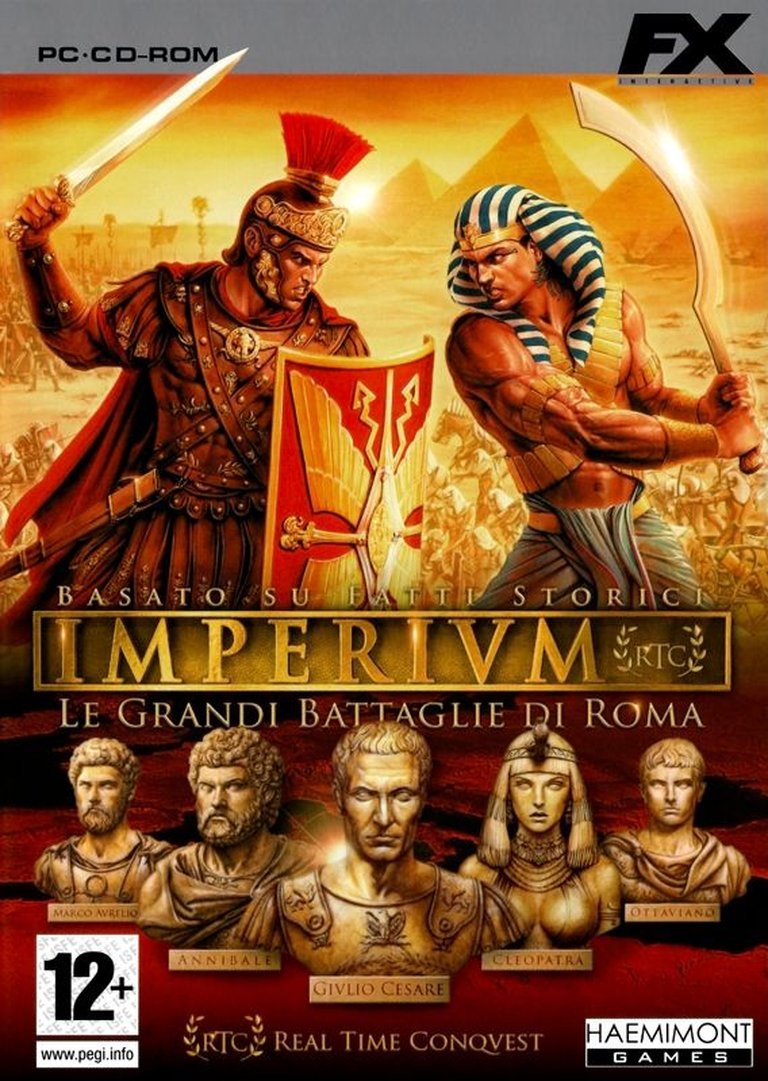- Release Year: 2004
- Platforms: Windows
- Publisher: FX Interactive, S.L.
- Developer: Haemimont Games AD
- Genre: Role-playing (RPG), Strategy, Tactics
- Perspective: Diagonal-down
- Game Mode: LAN, Single-player
- Gameplay: Business simulation, Managerial, Real-time strategy (RTS)
- Setting: Africa, Classical antiquity, Egypt (Ancient), Europe, Historical events, Middle East
- Average Score: 76/100

Description
Imperivm III: The Great Battles of Rome is an isometric real‑time strategy RPG that lets players lead one of eight ancient civilizations—including Republican and Imperial Rome, Carthage, Germania, Iberia, Egypt, Britain, and Gaul—through the Iberian Peninsula, Africa, Europe, and the Middle East. Instead of building infrastructure, the game focuses on military conquest: capturing or destroying towns and forts to gather the only two resources—gold and food—while incorporating tactical combat and modest RPG elements for heroes and units.
Gameplay Videos
Mods
Imperivm III: The Great Battles of Rome: Review
Introduction
In an era dominated by base-building RTS titans like Age of Empires and Command & Conquer, Imperivm III: The Great Battles of Rome (2004) dared to carve its own niche. Developed by Haemimont Games (later known for the Tropico series) and published by FX Interactive, this hybrid of real-time strategy and RPG mechanics refocused the genre on sheer military conquest. While overshadowed by contemporaries like Rome: Total War, Imperivm III stands as a flawed yet fascinating experiment in blending historical authenticity with streamlined tactical gameplay. This review argues that the game’s emphasis on hero-driven battles and minimalist economics deserves recognition, even if its conservative design limited its broader impact.
Development History & Context
Imperivm III emerged from Bulgaria’s Haemimont Games, a studio quietly honing its craft in historical strategy after 2002’s Celtic Kings: Rage of War and its 2003 follow-up, Nemesis of the Roman Empire. The early 2000s RTS landscape was fiercely competitive, with titles like Rise of Nations redefining scale and WarCraft III popularizing hero units. Haemimont aimed to differentiate itself by stripping away base-building—a bold choice in a genre defined by resource management—and doubling down on tactical combat.
Technologically, the game was modest even for 2004, requiring only a Pentium III processor and 256 MB RAM. This accessibility, paired with an isometric visual style, prioritized smooth performance over graphical prowess. FX Interactive, a Spanish publisher specializing in localized historical titles, marketed Imperivm III to European audiences eager for Rome-themed strategy, capitalizing on the post-Gladiator cultural zeitgeist.
Narrative & Thematic Deep Dive
Unlike narrative-driven RPGs, Imperivm III adopts a quasi-documentary approach. Players command one of eight civilizations—Republican Rome, Imperial Rome, Gaul, Germania, Carthage, Iberia, Egypt, or Britannia—across historical battles like the Siege of Alesia and the Battle of Zama. While there’s no overarching plot, the game leans into “great man” historiography, centering legendary figures like Julius Caesar and Hannibal as hero units.
Themes of empire-building and cultural clash are superficial but effectively framed through unit rosters and faction traits. For instance, Rome’s disciplined legions contrast with Gaul’s berserker-style warriors, while Carthage’s elephant units nod to its Mediterranean dominance. However, the lack of campaign storytelling beyond “conquer the map” relegates its historical depth to a decorative layer.
Gameplay Mechanics & Systems
Imperivm III’s defining innovation is its “Real Time Conquest” (RTC) focus. Players secure resources (gold and food) solely by capturing villages and structures, eliminating traditional farming or mining. This creates a relentless pace: every battle is a race to seize supply lines while managing attrition.
Combat hinges on unit composition, terrain, and hero abilities. Heroes like Caesar boost nearby units’ morale, while druids or shamans provide magical support. The RPG-lite progression system lets heroes unlock skills (e.g., healing or fear auras), adding strategic depth. However, micromanaging thousands of units (up to 5,000 on-screen) often overwhelms the rudimentary AI, which struggles with pathfinding and formation discipline.
The UI is functional but dated, with cluttered menus and limited camera control. Critics noted that the game felt iterative rather than revolutionary, offering only marginal improvements—four new factions, enhanced hero skills—over Nemesis of the Roman Empire.
World-Building, Art & Sound
The game’s isometric visuals evoke a board game aesthetic, with detailed unit sprites and recognizable landmarks (e.g., pyramids for Egypt). Maps span the Mediterranean, though environmental diversity is limited—forests and hills serve as static backdrops rather than interactive elements.
Sound design is utilitarian: clashing swords and war cries punctuate battles, while a subdued orchestral score reinforces the classical theme. While atmospheric, it lacks the grandeur of Total War’s dynamic music or Age of Empires’ cultural motifs.
Reception & Legacy
Critics praised Imperivm III’s accessible strategy loop but critiqued its lack of ambition. Spanish outlet Meristation (7.5/10) called it “complete and well-structured” but lamented its derivative core. Italian site Gamesurf Tiscali (7/10) argued it was “more of the same” with “no 360-degree innovation.” Player reviews were warmer (4.3/5), citing its pick-up-and-play appeal.
The game’s legacy is nuanced. While it didn’t revolutionize the genre, it showcased Haemimont’s knack for systemic design, foreshadowing their later success with Tropico. Modding communities kept it alive post-launch, adding factions like the Greeks and refining tactics. Today, it remains a cult favorite among RTS purists who appreciate its uncluttered focus on warfare.
Conclusion
Imperivm III: The Great Battles of Rome is a paradox: a game that simplifies RTS conventions to highlight tactical brilliance, yet struggles to escape its predecessor’s shadow. Its hero-centric combat and resource-as-conquest mechanics still feel fresh, but technical limitations and a lack of narrative ambition hold it back from greatness. For historians and strategy aficionados, it offers a compelling (if imperfect) window into Rome’s military machine. In the pantheon of RTS titles, Imperivm III is a footnote—but one worth revisiting for its bold deviations from the norm.